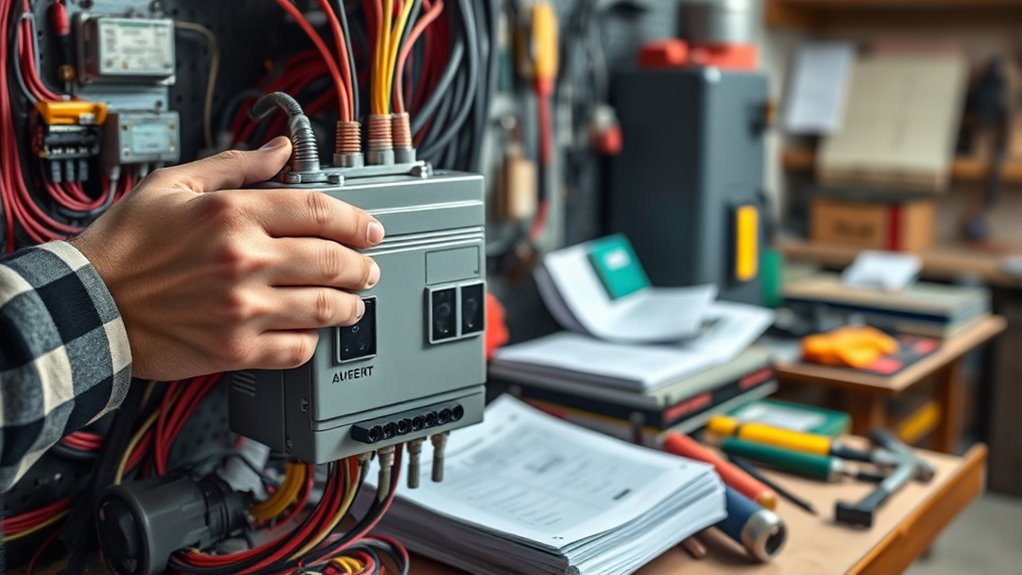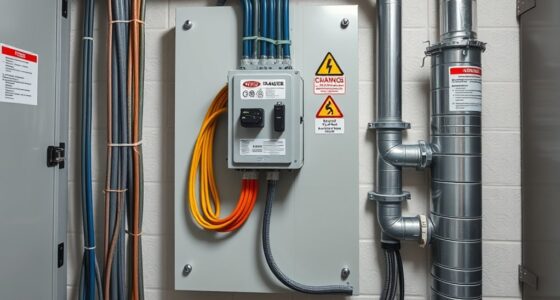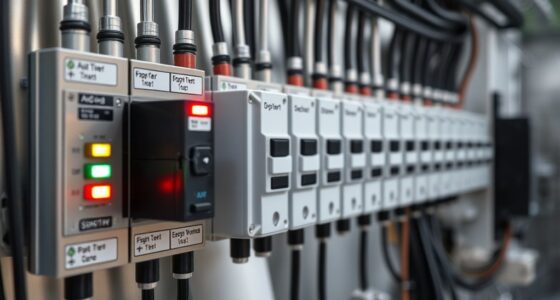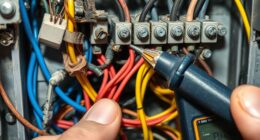Understanding the hidden costs of manual transfer switch basics begins with mastering key terms, load ratings, and system compatibility. Misinterpreting these can lead to purchasing the wrong size, incompatible parts, or costly upgrades. Proper installation, ongoing maintenance, and future-proofing are equally essential. Overlooking these details can cause delays, safety hazards, and unexpected expenses. Stay informed about these factors, and you’ll be better equipped to avoid costly mistakes—continue further to learn how to prevent these hidden issues.
Key Takeaways
- Understand industry terminology to select the correct transfer switch type, size, and features, avoiding costly mismatches.
- Accurately assess load ratings to prevent overloads or unnecessary expenses from over-specification.
- Verify system compatibility beforehand to prevent costly adapters, replacements, or system damage.
- Plan for future standards and upgrades to avoid obsolescence and expensive retrofits.
- Ensure clear communication with suppliers and proper installation procedures to minimize errors and safety risks.
Common Terminology That Can Inflate Your Costs
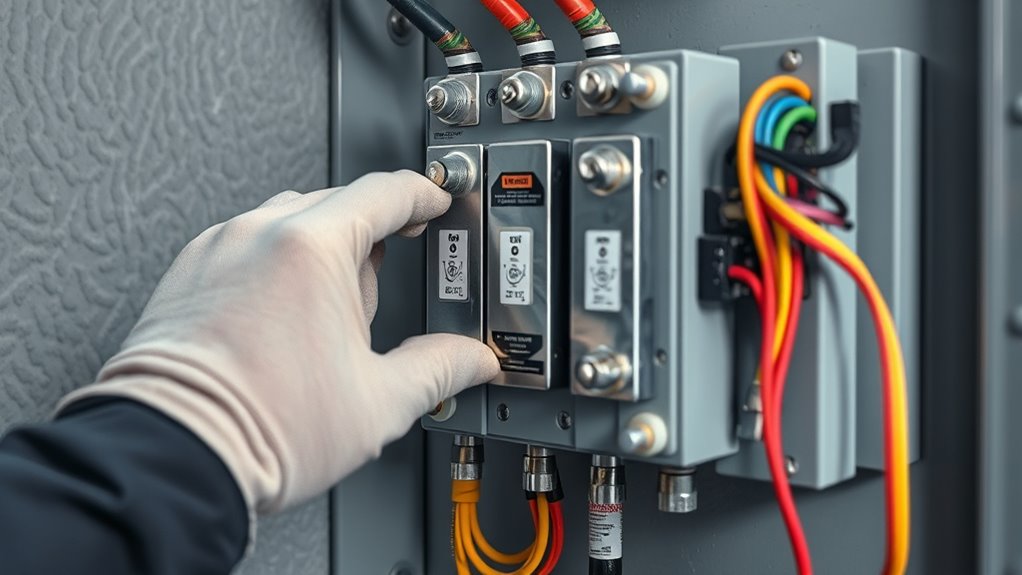
Understanding key terminology is essential because it helps you avoid common misunderstandings that can lead to unnecessary expenses. When dealing with transfer switch terminology, clarity is vital. Misinterpreting glossary definitions can cause you to select the wrong switch type or size, which may result in costly upgrades or replacements later. For example, confusing “manual transfer switch” with “automatic transfer switch” could lead to purchasing a more expensive unit than you need. Familiarize yourself with terms like “transfer relay,” “load rating,” and “transfer time” to guarantee you make informed decisions. Being confident in these glossary definitions helps you communicate effectively with suppliers and electricians, reducing the risk of costly mistakes and ensuring your system functions reliably when you need it most. Additionally, understanding the differences between various transfer switch types can prevent you from investing in features you don’t require.
Misunderstanding Load Ratings and Their Financial Impact

Misjudging load ratings can lead to significant financial consequences. If you underestimate the load capacity or misinterpret the power rating of your manual transfer switch, you risk overloads or system failures. Overloading a switch not only damages equipment but can also cause costly downtime and repairs. Conversely, choosing a switch with a higher-than-necessary load rating inflates upfront costs without added benefit. Understanding the correct load capacity ensures your switch can handle the maximum power demands safely. Properly matching the switch’s power rating to your system’s requirements prevents unnecessary expenses and protects your investment. By accurately evaluating these ratings, you avoid potential liabilities and ensure reliable operation. Clear knowledge of load ratings ultimately saves you money and keeps your system running smoothly. Additionally, staying informed about industry standards and power rating guidelines can further enhance your decision-making process.
Overlooking Compatibility and Its Hidden Expenses
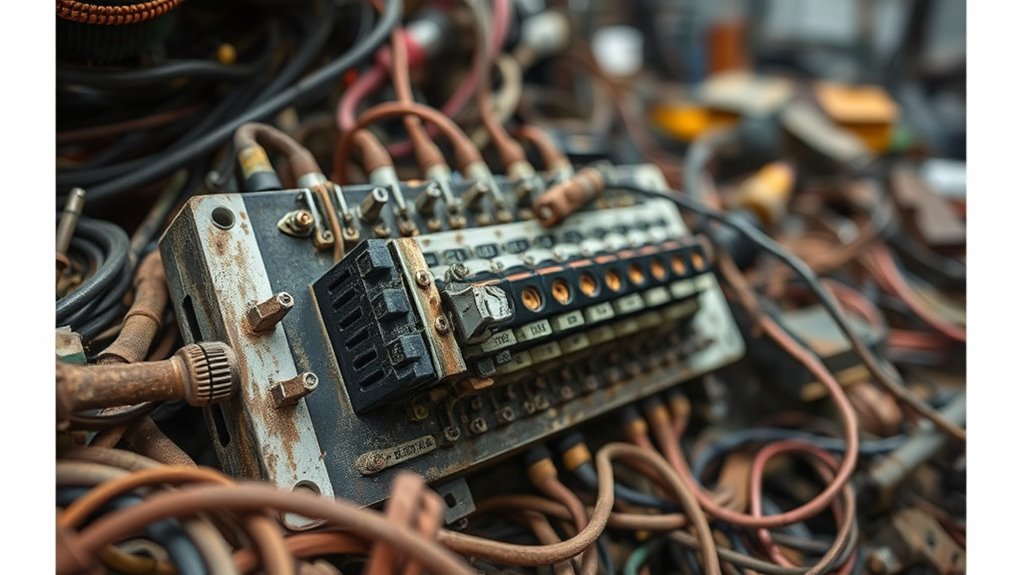
If your transfer switch isn’t compatible with your existing system, you could face costly mismatched components or need extra adapters. Overlooking future compatibility might mean replacing parts sooner than expected, adding unexpected expenses. Ensuring compatibility now saves you money and hassle later. Additionally, verifying that the transfer switch matches the system specifications can prevent issues related to discoloration or separation that indicate incompatibility.
Mismatched System Components
When system components are mismatched, it can lead to serious compatibility issues that often go unnoticed until problems arise. These system component mismatches can cause the transfer switch to malfunction or fail unexpectedly, resulting in costly repairs and downtime. Compatibility issues may stem from differences in voltage ratings, connector types, or control mechanisms, which aren’t always obvious at first glance. If you install a transfer switch without ensuring all components are compatible, you risk creating a system that doesn’t operate smoothly during an outage. Kia Tuning offers insight into how mismatched parts can affect performance, emphasizing the importance of proper component selection. This oversight can lead to damaging equipment or even safety hazards. To avoid these hidden expenses, always verify that your transfer switch and related components are designed to work together seamlessly, preventing costly troubleshooting and replacements later.
Additional Adapter Costs
Overlooking compatibility between your transfer switch and its components can lead to unexpected adapter costs. When parts don’t match properly, you might need additional adapters to connect everything, increasing your overall expenses. Compatibility issues often require purchasing specialized or custom adapters, which can be costly and add delays to your installation. These hidden expenses can catch you off guard if you assume all components are compatible out of the box. To avoid this, double-check the specifications of your transfer switch and its accessories before buying. Ensuring compatibility upfront helps you prevent unnecessary adapter costs and streamlines your setup process. Being proactive about compatibility can save you money, time, and headaches down the line. Additionally, understanding the importance of product compatibility in electrical systems can help you make more informed decisions.
Future Compatibility Risks
Failing to contemplate future compatibility can lead to significant expenses and installation setbacks down the line. As future standards evolve, your current manual transfer switch may become obsolete or incompatible, forcing costly upgrades. Overlooking upgrade considerations now can mean replacing the entire system later, which disrupts power reliability and inflates expenses. To avoid this, choose a transfer switch designed with flexibility for future standards, ensuring seamless integration with new equipment or control systems. This foresight helps you prevent unnecessary costs and reduces downtime during upgrades. By prioritizing future compatibility, you safeguard your investment, streamline maintenance, and ensure your system remains compliant with evolving industry requirements. Planning ahead minimizes hidden expenses and keeps your emergency power setup reliable for years to come. Additionally, understanding system scalability is crucial to ensure your transfer switch can adapt to increased load demands or expanded configurations in the future.
Costly Mistakes in Wiring and Installation Terms
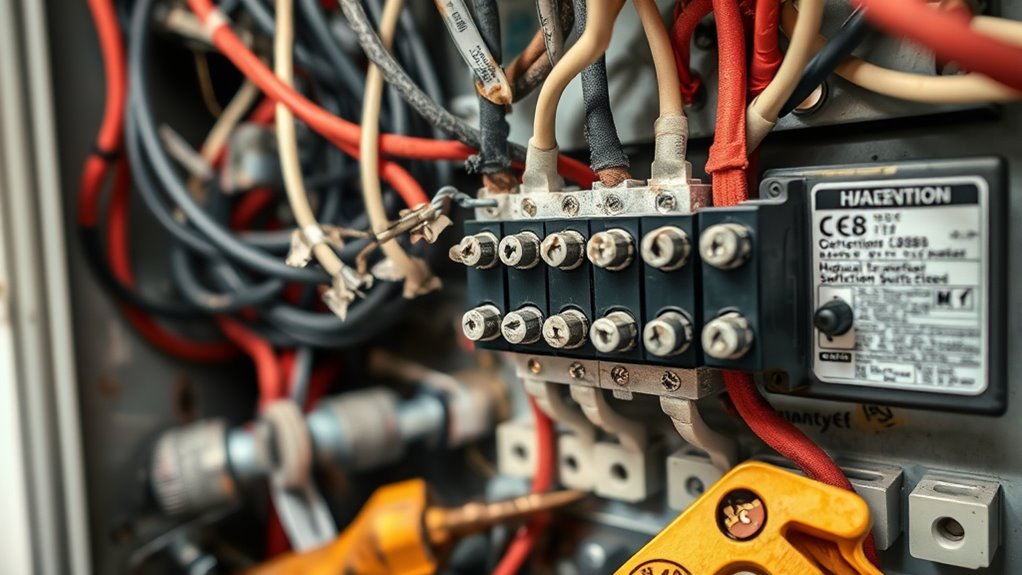
Wiring and installation mistakes can lead to serious safety hazards and costly repairs. One common error is underestimating wiring complexity, which can cause improper connections or overloads. Misunderstanding installation procedures may result in incorrect setup, risking damage to the transfer switch or your electrical system. Failing to follow manufacturer guidelines or skipping essential steps can compromise safety and reliability. For example, improper grounding or loose connections can cause sparks or electrical fires. Always verify you understand the wiring diagrams and adhere to local codes. Rushed installations or neglecting detailed instructions can lead to vetted errors that compromise safety and increase costs. Taking the time to get wiring and installation right saves money and keeps your system safe and operational in emergencies.
The Price of Ignoring Maintenance and Testing Language
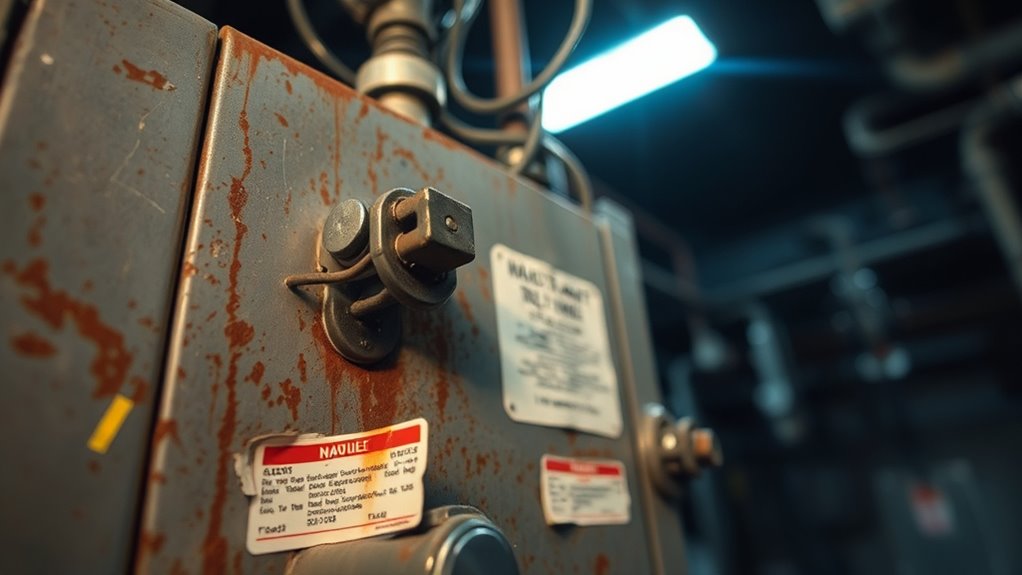
Ignoring maintenance and testing instructions can lead to unexpected failures when you need your manual transfer switch most. Without proper preventive maintenance, components can wear out or become corroded, increasing the risk of malfunction during a power outage. Skipping testing protocols means you won’t identify issues early, risking unanticipated breakdowns when critical. Regular inspections and scheduled testing ensure the switch operates reliably and safely. Neglecting these instructions may also void warranties and lead to costly repairs or replacements down the line. By adhering to clear maintenance and testing guidelines, you extend your transfer switch’s lifespan and ensure it functions correctly when needed most. Investing in routine preventive maintenance ultimately saves you money and prevents emergency failures you can’t afford.
How Ambiguous Specifications Lead to Unexpected Expenses

Ambiguous specifications in transfer switch manuals or product descriptions can lead to unexpected expenses by causing misinterpretations during installation or maintenance. When the details aren’t clear, you might purchase the wrong components, install equipment incorrectly, or require costly rework. These misunderstandings often result in delays, additional labor, or even equipment damage—all contributing to unexpected expenses. To avoid this, pay close attention to vague language, ask for clarification from suppliers, and verify specifications before proceeding. Being proactive helps you prevent costly mistakes. Remember, ambiguous specifications can undermine your budget and project timeline. Stay vigilant and seek precise details to ensure smooth operation and avoid unnecessary costs. Clear communication now saves you money later.
Strategies for Clarifying Terms to Save Money
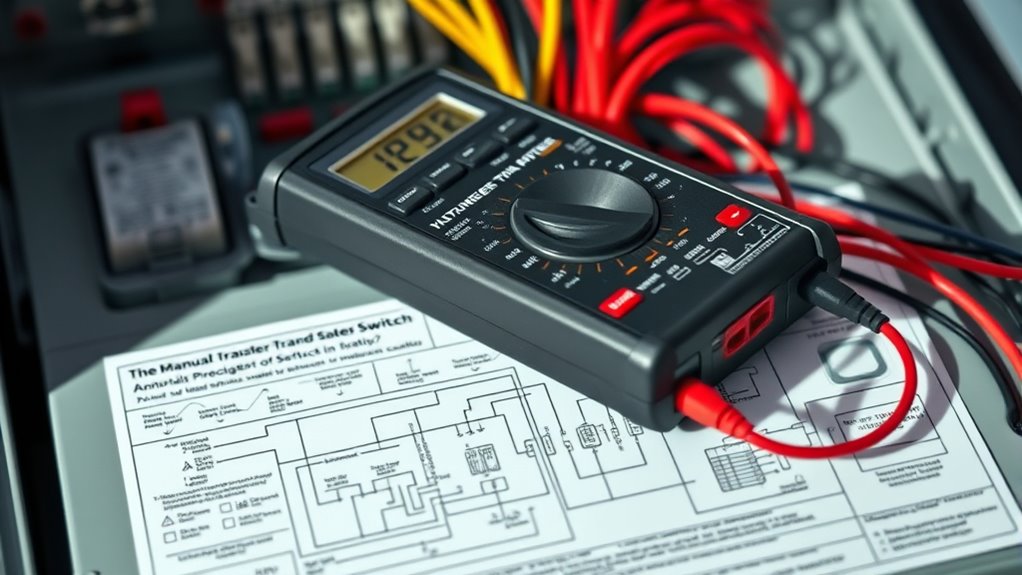
To prevent costly misunderstandings, it’s essential to clarify all terms and specifications before starting your transfer switch project. Ask suppliers for detailed documentation and request clear explanations of key features and ratings. This promotes supplier transparency, helping you verify exactly what you’re getting. Conduct a thorough cost comparison by comparing quotes that specify parts, installation, and maintenance costs. Don’t accept vague descriptions or generic terms; instead, seek precise definitions to avoid surprises. Clarify technical terms, compatibility requirements, and warranty details upfront. This proactive approach reduces the risk of unexpected expenses later. Additionally, understanding cookie policies can help you manage privacy preferences when communicating with suppliers online. By ensuring everyone is on the same page, you can make informed decisions, avoid overpaying, and select the best transfer switch for your needs—all while saving money.
Frequently Asked Questions
How Do Unclear Switch Specifications Affect Long-Term Costs?
Unclear switch specifications can lead to costly mistakes because you might choose a switch that isn’t compatible with your system’s voltage standards or other equipment. This mismatch causes frequent failures, increases maintenance costs, and may require expensive replacements. To avoid these hidden costs, make sure you understand switch compatibility and voltage standards before purchasing. Clear specifications help you select the right switch, saving you money and hassle in the long run.
Can Poor Terminology Understanding Lead to Overestimated Project Budgets?
Yes, poor terminology understanding can lead to overestimated project budgets. When your team lacks terminology clarity, you might misunderstand equipment specifications or installation requirements. This confusion hampers accurate planning and inflates costs unnecessarily. Using a clear glossary with precise definitions helps guarantee everyone’s on the same page, reducing the risk of costly mistakes and keeping your project within budget. Clear terminology ultimately streamlines communication and cost management.
What Hidden Expenses Arise From Misinterpreting Transfer Switch Ratings?
Misinterpreting transfer switch ratings can lead to hidden expenses like installation errors and warranty claims. When you select a switch with an incorrect rating, you risk equipment damage and safety hazards, which may require costly repairs or replacements. These mistakes often cause delays, increasing labor costs. Overlooking proper ratings also voids warranties, leaving you responsible for future repairs. Accurate understanding helps you avoid these costly pitfalls and ensures reliable, safe operation.
How Does Improper Documentation Increase Installation or Maintenance Costs?
Improper documentation can substantially increase your installation or maintenance costs. Faulty wiring may go unnoticed, leading to potential safety hazards and costly repairs down the line. Incomplete labeling can cause confusion during operation or troubleshooting, resulting in delays and additional labor expenses. When your documentation isn’t thorough, you risk misinterpretation and mistakes, which ultimately inflate your project’s expenses and compromise system reliability. Always guarantee documentation is clear, complete, and accurate.
Are Ambiguous Terms in Manuals Likely to Cause Safety-Related Expenses?
Ambiguous terms in manuals can definitely lead to safety-related expenses. When manual terminology isn’t clear and labeling lacks clarity, you risk misinterpreting instructions, which can cause improper installation or operation. This increases the chance of accidents, damage, or system failure, all of which cost you more in repairs and downtime. Ensuring your manuals have precise language and clear labeling helps you avoid these costly safety issues, keeping your system safe and reliable.
Conclusion
By understanding key terms and avoiding common misunderstandings, you can prevent costly surprises. For example, neglecting load ratings led a facility to upgrade an outdated manual transfer switch prematurely, costing thousands. Clarifying specifications upfront saves money and guarantees reliable operation. Take the time to ask questions and review terminology carefully—your budget and system depend on it. Don’t let hidden costs catch you off guard; stay informed and proactive.
